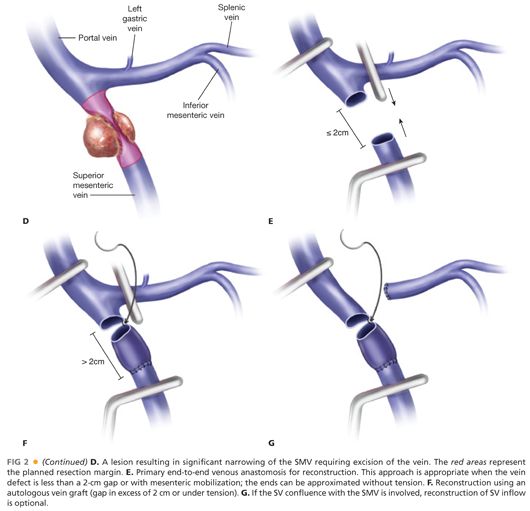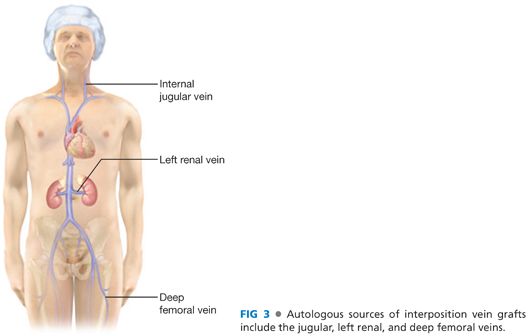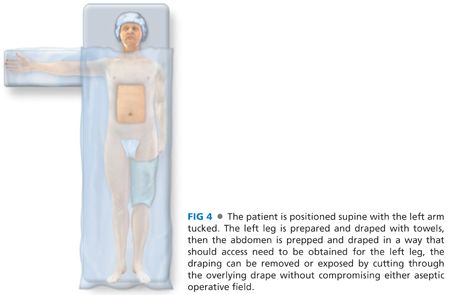■ Obtain bilateral duplex ultrasound studies of the deep femoral and jugular veins. Surface mapping of deep femoral vein assists in harvesting the conduit but is not required for success.
PREOPERATIVE PLANNING
■ Key to success is the accurate, preoperative determination that an interposition graft will be required.
■ If the vein is narrowed, plan for a circumferential excision with primary repair versus interposition graft. Using the CT scan, estimate the length of the PV involved and the resulting defect requiring reconstruction (FIG 2).
■ A defect measuring less than 2 cm can usually be repaired primarily.
■ A defect 2 to 4 cm typically can be reconstructed using an interposition graft.
■ Defects measuring more than 4 cm will result in a long-segment conduit; the risk of graft thrombosis is proportional to the length, and longer segment reconstructions may preclude surgical therapy.


■ Tumor involvement with respect to the splenic vein (SV) and superior mesenteric vein (SMV) confluence must be considered.
■ If the lateral wall is involved, a primary transverse repair or patch repair is ideal.
■ If a circumferential vein resection is required and a primary end-to-end anastomosis or interposition graft planned, most experienced surgeons do not reinsert the SV—this significantly increases the complexity of the procedure. Rather, the SV is ligated proximally. The risk of sinister portal hypertension leading to symptoms is acceptably low.
■ Consider initiating or continuing a daily enteric-coated aspirin (81 mg) through the perioperative period.
■ Have a bovine pericardium patch available.
■ Most centers have abandoned the use of cadaveric vein grafts.
■ Strongly consider a neoadjuvant approach for all patients with borderline resectable disease. An R1 resection confers no survival benefit over a nonsurgical, palliative therapeutic approach.
■ Neoadjuvant therapy should be offered to all patients in whom there is a loss of the fat plane around the superior mesenteric artery (SMA).
TECHNIQUES
POSITIONING
■ Tuck the left arm. This will provide better access to the left neck should the jugular vein need to be procured as a graft (FIG 3).

■ Place either an upper or lower body active warming device; this decision is driven by the planned source of conduit.
■ Prepare the patient’s skin. Then, isolate the left neck or left thigh and abdominal operative fields with sterile towels (FIG 4). Ensure that these towels create a sterile field between these isolated sites. Use ¾ sterile drapes as indicated to achieve this objective. The authors support the use of iodine-containing, self-adhesive barriers to secure these fields under the additional overlying draping and reduce the risk of surgical site infections.

■ To minimize the risk of hypothermia, drape the patient such that only the abdominal operative field is exposed. This drape will be cut to expose the graft harvest site when indicated.
INCISION AND EXPOSURE
■ Either a midline or bilateral subcostal incision can provide adequate exposure. In addition to exposing the upper abdomen, the incision must allow for complete mobilization of the right colon and retroperitoneal attachments of the small bowel mesentery.
DISSECTION
■ The dissection proceeds for the most part as presented in detail in Chapter 36 but may include limiting particular portions of the dissection; most importantly, the uncinate process/SMA dissection is performed prior to dissection of the SMV/PV.
■ Perform a complete Cattell-Braasch maneuver, fully mobilizing the retroperitoneal attachments of the cecum, right colon, and small bowel mesentery to the left of the aorta and up to the third portion of the duodenum.
■ As part of the Kocher maneuver, establish a plane between the third portion of the duodenum and the aorta and extend this dissection cephalad to the origin of the SMA (FIG 5).

■ Mobilize the ligament of Treitz and derotate the small bowel such that the cecum is in the left upper quadrant.
■ These maneuvers will provide excellent exposure and mobility of the mesentery to facilitate primary reconstruction without undue tension following mesentericoportal resections up to 2 to 3 cm in length.
■ This mobilization will also expose the anterior aspect of the left renal vein—a potential source of reconstruction conduit.
■ Open the lesser space and expose the pancreatic head. Assess the root of the transverse mesocolon and bimanually palpate the lesion. Also, palpate the course of the SMA with respect to the palpable lesion.
■ Proceed with the dissection of the inferior and superior borders of the pancreas, identifying the anterior borders of the SMV and PV proximal and distal to the area of tumor involvement, respectively.
■ By palpation and visualization, identify the relationship of the tumor with respect to the SV/SMV confluence.
■ Establish the plane between the root of the mesentery and the third and fourth portions of the duodenum and uncinate process.
■ Determine resectability with respect to involvement of the SMV/PV and the extent of resection required (FIG 2).
■ A very small segment of the lateral wall of the SMV/PV is involved—a side-bite clamp placed longitudinal to the vein will provide adequate resection margin (2 to 3 mm) and vascular control. Note: A longitudinal clamp will not allow a transverse closure of the resulting defect due to tension; the clamp will typically need to be repositioned transversely. Thus, the authors rarely use a side-biting clamp technique and usually obtain circumferential, proximal, and distal control.
■ Unless a plane can be readily established anterior to the SMV/PV confluence (i.e., only the lateral wall of the vein is involved), save division of the pancreatic neck for later.
■ Proceed with the other steps of the dissection.
■ Dissect the porta hepatis and divide and control the bile duct and gastroduodenal artery.
■ Divide the proximal gastrointestinal (GI) tract (duodenum or stomach).
■ Approaching from the posterior–inferior, dissect the uncinate process and duodenal mesentery from the SMA, hugging the adventitial plane while working caudad to cephalad until the lateral aspect of the SMA has been fully dissected up to its origin from the aorta. An energy device can be used for much of this dissection, but the authors recommend ligation or suturing of any identified inferior pancreaticoduodenal artery (FIG 6).

■
Stay updated, free articles. Join our Telegram channel

Full access? Get Clinical Tree








